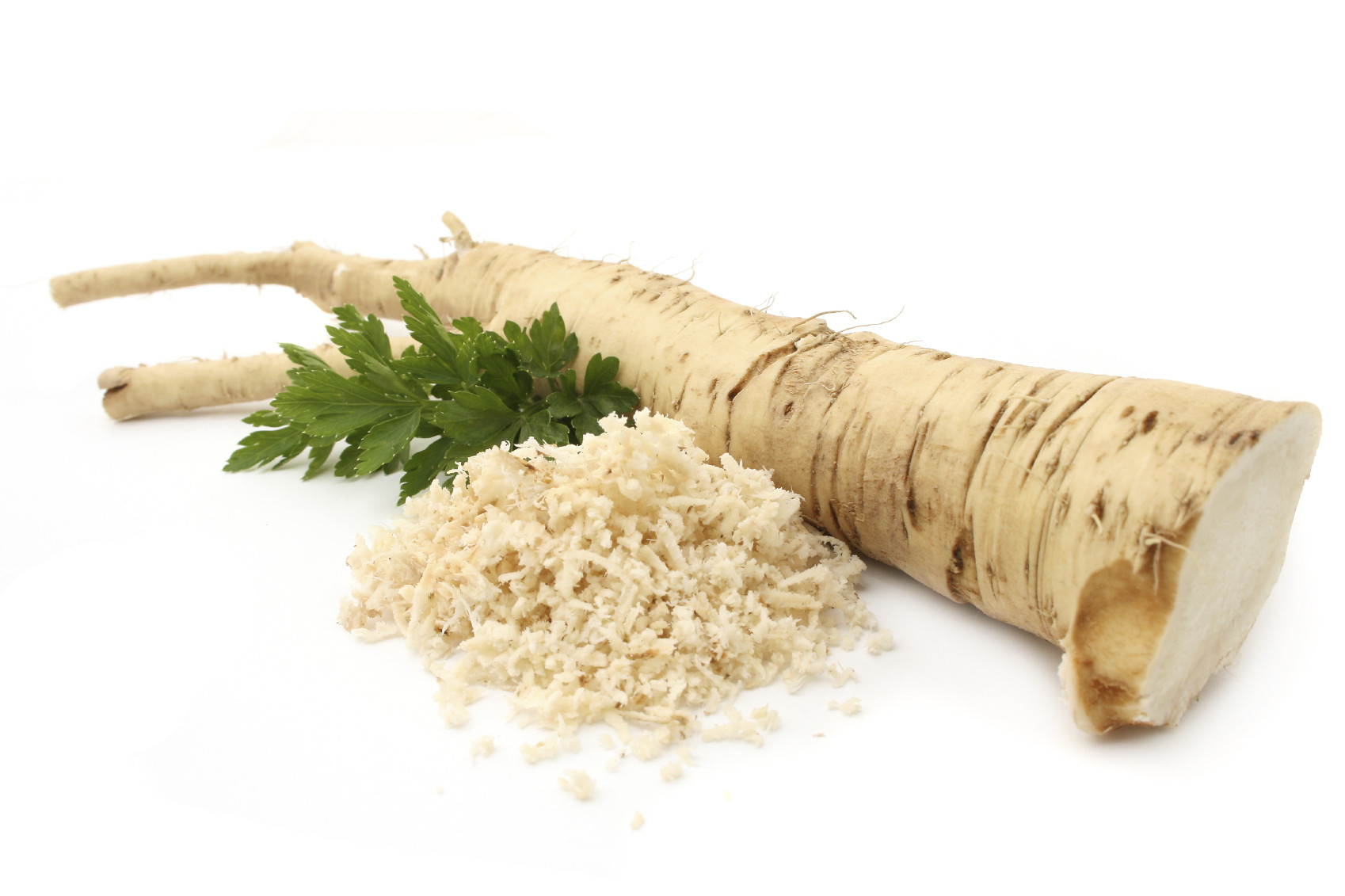Horseradish, also known as pepperrot, red cole, great raifort or mountain radish, is a perennial plant with large, crinkled leaves coming from Europe and Western Asia mainly used as a condiment in sandwiches or marinades with sharp, pungent, spicy taste just like the mustard seeds, known as an excellent stimulant for fatty meals. Coming from the Brassicaceae family, horseradish is a genus of Armoracia rusticana having white, thick, fleshy roots growing up to 5 feet tall favoring cool climates with plenty of sunlight.
Enzymes that help the plant defend from pests, while alive, produce during breakdown from sinigrin a mucous irritating mustard oil and that’s the main ingredient horseradish is cultivated for. Horseradish is low in calories and fat while supplying high amounts of Vitamin C (an important antioxidant) and small contents of:
- Potassium – helps heart health
- Magnesium – necessary to maintain muscle and neural functions normal as well as keeping the heart pumping rhythmically
- Folate – or Vitamin B9 encourages white blood cell, tissue growth, and DNA repair
- Phosphorus – improves energy extraction from fats, helps bone development and protein formation and also plays an important role in cell repair
- Iron – found mostly in the red blood cells helps carry oxygen throughout the body
- Zinc – has immune boosting properties and even a small deficiency can cause serious health conditions
- Vitamin B – maintain a healthy skin and hair and it’s also known to reduce the risk of stroke [1]
- Calcium – an essential part of bone, heart, muscles and nerves health
Main Health Benefits of Horseradish
This vegetable also contain a cancer-suppressing type of glucose called glucosinolates (a substance normally used by the plant as a shield against toxic conditions), known to help prevent and fight tumors by eliminating free radicals and inhibiting the mutation of healthy cells into tumor cells and even inducing cancer-protective genes preventing different types of cancer, including colorectal and lung cancer. A study conducted at the University of Illinois [2] found that horseradish contains up to 10 times more glucosinolates than broccoli (also a member of the Brassicaceae family) closely related to wasabi and cabbage.
The sinigrin and isothiocyanate found in the root of the horseradish promote the production of white cells that help strengthen and boost the immunity system together with the Vitamin C – also well known for it’s immunity benefits. Its high fiber and rich protein structure could reduce overeating making this veggie ideal for any weight loss diets.
The traditional treatment is for sinusitis and bronchitis and can be as effective as antibiotics by chewing or taking half a cup of horseradish in the morning or afternoon. Just make sure not to dilute the grated or smashed horseradish and not to drink or eat anything for a short period of time. It has been observed that inhalation of grated root stimulates the release of the beneficial oils that help congestion of the upper respiratory tract. Caution is required as this is usually followed by a powerful sensation on the back of your head associated with tearing and sweating.
The allyl isothiocyanate compound found in this 2000 years old plant have antibacterial properties that can defend against microbes, bacterial infections like E. coli, Listeria, and/or Staphylococcus. This is why it’s largely used for the treatment of UTI (urinary tract infections) by delivering antibiotic benefits to the bladder and stimulating elimination of harmful bacteria or inflammatory toxins making it a powerful diuretic.
It is also recognized for lowering the blood pressure and controlling the movement of vitamins and minerals between cellular membranes by stimulating the blood flow. Combining it with some olive oil and used externally it acts as a rubefacient to relieve muscular aches and pains and even chest pains by increasing warmth and circulation.
Even if could be dangerous during pregnancy and lactation because of the irritants released, it’s high levels of folate protect both mother and son and reduces the occurrence of NTD (neural tube defects) such as spina bifida.
Horseradish Side Effects and Warnings
Irritation is considered the main disadvantage of this ancient plant and can affect mouth, throat, stomach, and urinary tract when used internally, as an aliment, or the skin when used externally causing diarrhea, vomiting, thyroid dysfunction and skin redness or rash. Because of this, people suffering from stomach, intestinal ulcers, hypothyroidism or kidney disorders should avoid the use of horseradish. There is no medical information on what the appropriate dosage should be and it depends on the individual age, weight, and overall health so make sure to consult a healthcare specialist before using it.
It can be used as a:
- Freshly grated root for up to 4g before meals
- Infusion tea with 200 ml boiled water and steep 3g for 5 minutes
- Succus from 20 g of fresh juice
- Syrup – add – [highlight color=”orange”]120g grated horseradish + 3 lemons + 2.5 spoons of honey + 1 tablespoon of cinnamon + 1 small piece of ginger
Pay attention and treat grated horseradish as a dangerous gas as it releases strong and volatile oils when sliced or smashed, more intense than a pile of onions, so make sure to keep your distance shortly after handling the root. It may take a few minutes before the oils will dilute into the air making it less harmful. Lemon or vinegar inhibits this reaction and it’s the best way of preserving the flavor of the plant
If you are wondering if horseradish is a fruit or a vegetable then you must learn that it is a vegetable and its leaves are used in different dishes even if the root part of the plant provides the main health benefits.
Even if used for centuries for its medicinal attributes, horseradish sauce is the most popular utilization of this amazing plant and it comes in many recipes that mainly contain vinegar, pepper, and dry mustard.


